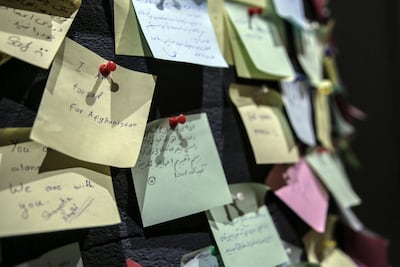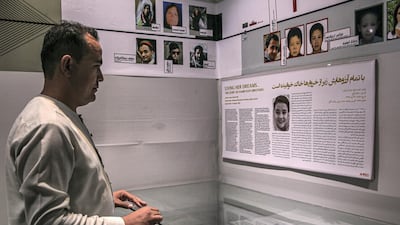Quiet music is playing in the narrow, dimly lit staircase leading down to the basement of a West Kabul house.
From the outside it doesn't look any different from the other homes lining the wide, tree-lined road, but inside live the memories of Afghanistan's long war's victims.
The room, with its dark floors and white walls has been filled with glass vitrines - memory boxes documenting the lives of those who died at the hands of the war's perpetrators over the past 40 years.
The museum, hosted at the Afghanistan Centre for Memorial and Dialogue (ACMD) first opened at the beginning of 2019, attempting to both remember victims and capture the stories of lives lost.
Hamidullah Rafi agreed to have the museum exhibit his sister Rahila's story.
Two years ago in August 2018, he arrived to chaos and carnage, frantically looking for his sister who had been studying at a West Kabul university prep centre in the Dasht-e-Barchi neighbourhood that had just been the centre of an ISIS attack. After hearing about the attack from a relative, Mr Rafi immediately made his way there.
He remembers one woman, covered in tears, screaming her daughter’s name; another girl, her face pain-struck, shouting for her sister.
The attack – perpetrated by a suicide bomber on foot – would take the lives of 48 people and injure dozens more, most of them students studying for their university entrance exams.
Mr Rafi’s sister Rahila, an ambitious 17-year-old who worked as an English instructor on the side and hoped to work in economics, was among the dead.
"We drove from hospital to hospital, searching admission lists for her name. We didn't want to search for the dead bodies then, we didn't want to give up hope," Mr Rafi told The National.
The family eventually found Rahila at the morgue, recognisable only by her clothes and the watch she had been wearing.
Two years on, it could have been easy for the attack, its victims and the devastation wrought among families to fade into obscurity among the hundreds of similar atrocities committed across the war-torn country.
But today, snippets of Rahila's memories, including a cabinet with some of her belongings - her watch, her diary, even an ID card - are kept at the museum's showroom.
Thirty-six of such memory boxes, as well as around 5,000 other stories are collected here, back to 1978, when the Soviets invaded Afghanistan.
As the Taliban and the government have, for the first time, started direct negotiations in Qatar’s capital Doha, hoping to reach a possible peace and power sharing deal, the question of what happens to the war’s victims becomes all the more relevant.
“The testimonies on display here show that perpetrators came from all sides: the Soviets, the Mujaheddin, the Taliban, the government, the US, the Islamic State and other affiliated groups,” explained ACMD’s Associate Fatima Alawi, adding that each testimony has been collected by the Afghanistan Human Rights and Democracy Organisation, a non-profit group working with war victims.
Mr Rafi agreed to have his sister’s story exhibited, saying that victims had so far been excluded from the peace process, as well as any negotiations.

He hoped that her story would help raise the importance of victim inclusion.
“After the attack, I found Rahila’s diary,” he said.
“She had been journaling about peace, hoping that one day she could contribute to solving the crisis. That’s why she wanted to study hard. I couldn’t stop my tears reading her words.”
Afghanistan’s Independent Human Rights Commission (AIHRC) has called for both justice and the inclusion of victims in the peace process.
“Recovery will depend on reconciliation and development at the national and community level. The right to justice must be preserved for serious crimes that targeted civilians, including reparations for victims,” a Commission report released ahead of the Taliban and government's meeting in Doha said.
Haji Sardar Mohammad, 70, is another person whose story is exhibited at the museum. A tribal elder and district council head from the southern Kandahar province, he said the Taliban was after him, attacked his house several times, but eventually killed his 25-year-old son Essa.
“Two Taliban members were standing [outside my house], demanding he would come with them. He refused and they shot him. You cannot trust them. One of them makes peace with you, the other comes and kills you,” Mr Mohammad said in his testimony, written out and placed over his son's memory box containing photos and even clothes.
His son, he said, had been a farmer. He had just returned from the mosque, sitting at home with his family when the Talibs arrived.
"There are no official records of victim stories, so we are trying to change just that," Fatima Alawi told The National.
“Each victim has the right to be heard, each life needs to be preserved.”
A wall filled with sticky notes is propped up at the museum’s exit. Most messages are written in Dari and Pashto, some of them are in English.
“This war has been enough,” reads one of them. “Peace is all we need in our country.”

